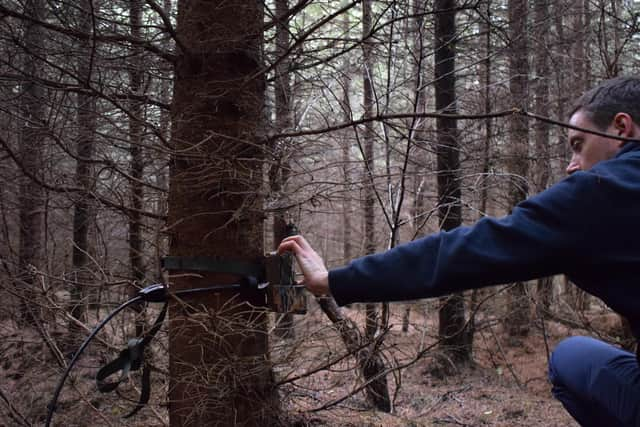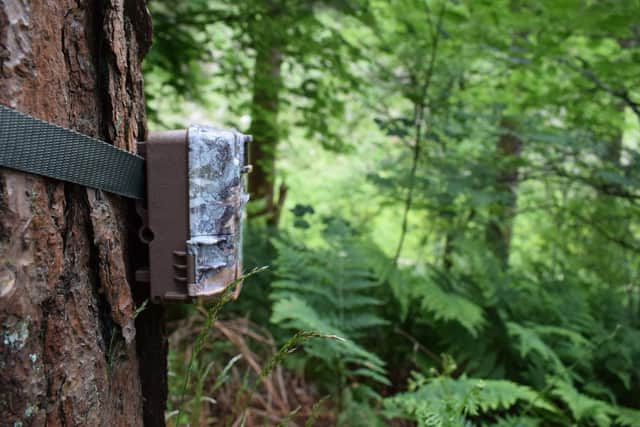The hidden cameras searching for evidence of rare pine martens in Yorkshire
But a group of dedicated volunteers are not giving up hope of capturing more evidence of these elusive creatures and proving that they still live in our forests.
In the late summer of 2017, social enterprise Nature Spy managed to film three separate clips of a male pine marten in a forest in the North York Moors using hidden cameras.
Advertisement
Hide AdAdvertisement
Hide AdIt was the first live record of a pine marten in Yorkshire for 35 years, and the first evidence of any kind since 1993, when a gamekeeper found a skull in a snare trap.


Yet over two summers on, the pine marten appears to have moved on, and there have been no further sightings.
James McConnell, a director of north Wales-based Nature Spy, explains that they first began looking for pine martens in the North York Moors in 2014 after years of ‘anecdotal’ sightings that had never been verified. Camera traps had never been used before, but three years later they vindicated the belief of the project managers and volunteers who were convinced pine martens were living in the area.
They then applied to the Heritage Lottery Fund for another three year’s worth of grant funding, which they were awarded, and the Forestry Commission joined the project as partners.
Advertisement
Hide AdAdvertisement
Hide AdThere are now over 60 cameras positioned all over the main site, and in total 10 forested areas of the National Park are being monitored. Den boxes have also been installed.


“We now have a blanket survey and there are cameras everywhere - but it took us four years to find a pine marten. They are very elusive. We went through thickets in the remote parts of the forest but then filmed it close to one of the main cycle paths.
“It’s tricky to say what could have happened to him. He may have moved on to look for a female to mate with. There is some pressure with gamekeepers in the area, who trap stoat and weasel. He could have died of natural causes. They also roam across a massive range in the summer.”
James thinks the pine marten most likely came from an established population in Kielder Forest in Northumberland, but admits there are numerous reports of them being seen in the North York Moors submitted by locals.
Advertisement
Hide AdAdvertisement
Hide Ad“There is anecdotal evidence of a remnant population there, and you get occasional reports from the Dales, although we don’t think they have the right level of forest cover there. There are none to the south.
“What we would love is to find some poo so we can extract DNA and find out where he came from.”
Sightings are ranked and verified via an interview system which weeds out glimpses of what are more likely to have been weasels.
A man reported seeing a pine marten in Helmsley at around the same time as the footage was filmed, while an experienced ferret-keeper claimed to have seen one on a path in Cropton Forest. Someone else believed they’d seen a dead body on the road from Pickering to Dalby, but when they returned to the spot it had gone.
Advertisement
Hide AdAdvertisement
Hide Ad“It’s very difficult to verify them. Often, when pine martens get a bit of publicity, we have a flurry of sightings. We even had someone who claimed they’d fed them jam sandwiches in Whitby!
“There is a lot of confusion with stoats.”
Pine martens are in decline because of a range of factors. Habitat loss has been detrimental - they prefer ancient woodland with low-hanging branches that make ideal den sites. The preservation of Scotland’s old Caledonian pine forests has helped in enabling the population north of the border to stabilise at around 4,000.
Persecution - they have been both hunted for their fur and trapped to protect game birds - has also contributed to a reduction in numbers, but they are now a legally protected species.
Project officer Ed Snell first became involved in the monitoring as a volunteer, and now spends two days a week managing the camera traps.
Advertisement
Hide AdAdvertisement
Hide Ad“We have a much greater capacity now to respond to sightings. Some of them come from forestry workers, others from farmers and some from the public. It can be tricky to identify them as they look similar to stoats, polecats and mink. We really need that photographic evidence.
“They thrive in older forests, and persecution has pushed them out. They can be hard to track down.
“We were optimistic that we would eventually film one and it was so exciting when we did after waiting for years. Part of the project is also to study how pine martens interact with other species - they compete with foxes for the same resources, so habitat suitability varies from area to area. We are working with landowners to engage with them.”
Pine martens in England
The English population was considered extinct until the last decade, when firm evidence of their presence was finally recorded. Pine martens are the second-rarest carnivorous mammal in Britain.
Advertisement
Hide AdAdvertisement
Hide AdDroppings were found at Kidland Forest in Northumberland in 2010 and DNA tested for confirmation. They were thought to suggest either a recolonisation by the Scottish population, or a relict population that had not been previously verified.
In 2011 droppings were discovered in Cumbria, and in 2015 the first actual sighting of a pine marten in over a century was filmed in woodland in Shropshire.
After the North York Moors sighting in 2017, footage was captured in Northumberland the following year by a conservation project called Back From The Brink.
Comment Guidelines
National World encourages reader discussion on our stories. User feedback, insights and back-and-forth exchanges add a rich layer of context to reporting. Please review our Community Guidelines before commenting.